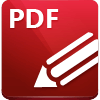 Accessibility Check
Accessibility Check
The Accessibility Check feature in PDF-XChange Editor enables you to verify whether document conforms to international accessibility standards. Conformance with these standards ensures accessibility for people with disabilities who use technology such as screen readers, screen magnifiers and other equipment to navigate and read electronic content. The Accessibility Check contains thirty-two rules that are used to determine the accessibility of documents. They concern specific elements of documents and are therefore grouped into the following categories:
Document
•Accessibility Permission Flag reports the need to enable the security settings that permit accessibility. This is because some documents contain permission settings that prevent them from being copied, edited, printed, extracted and/or annotated. These settings may interfere with a screen reader's ability to read the document, because screen readers must be able to copy or extract document text in order to read it to the user. The Accessibility Permission Flag reports whether or not it is necessary to turn on the security settings that allow accessibility for the screen reader.
•Image-Only PDF reports that documents contains only inaccessible, non-text content such as images. (Note that some images may be of text - in those cases, if the document does not contain fonts, then the text will not be recognized).
•Tagged PDF reports whether documents contain tags that specify the order in which document content should be read.
•Logical Reading Order must be checked manually and is included to ensure that the reading order in the Tagged panel follows the logical reading order of the document.
•Document Language reports whether the primary text language of documents is specified, and allows some screen readers to switch to the specified language.
•Title reports the title of documents as detailed in their document properties.
•Bookmarks reports whether documents that contain twenty-one or more pages also have bookmarks that match the document structure.
•Color Contrast reports whether documents are sufficiently accessible for colorblind users.
Page Content
•Tagged Content reports the status of document content, which must be either tagged or marked as an artifact (such as graphics or decorative images) in order to conform to accessibility standards.
•Tagged Annotations reports the status of annotations in documents. Annotations must be either tagged or marked as artifacts to satisfy this rule.
•Tab Order reports whether the tab order of documents matches the document structure.
•Character Encoding reports whether documents contain the encoding required to display the fonts that they contain.
•Tagged Multimedia reports the status of document multimedia objects, which must be either tagged or marked as artifacts in order to conform to accessibility standards.
•Screen Flicker reports whether documents contain content that causes the screen to flicker. This type of content can be difficult to see when the screen is magnified and can cause seizures in people who have photosensitive epilepsy.
•Scripts reports whether documents contain scripts that interfere with keyboard navigation or prevent the use of input devices. Document content and functionality must not be script-dependent unless it is accessible to assisting technology.
•Timed Responses reports whether documents contain forms with JavaScript that require a response from users within a specified time frame.
•Accessible Links reports whether the URLs in documents are tagged correctly, as well as whether there are several identical links within the same document. URLs must be active and correctly tagged in order to be accessible to screen readers.
Forms
•Tagged Form Fields reports whether all document form fields are tagged.
•Field Descriptions reports whether all form fields contain a text description, which is requirement for accessible documents.
Alternate Text
•Figures Alternate Text reports whether document images either have alternate text or are marked as artifacts. All document images must fall into these categories in order to conform to accessibility standards.
•Nested Alternate Text reports whether documents contain nested alternate text, which screen readers do not read.
•Associated with Content reports whether alternate text is associated with page content. This rule is necessary because in cases where document elements have alternate text but do not contain page content it is not possible to determine the document page with which the alternate text is associated.
•Hides Annotation reports whether alternate text hides annotations, because screen readers are unable to read annotations in cases where they are nested under a parent element that has alternate text.
•Other Elements Alternate Text reports whether documents contain content (other than figures) that require alternate text, such as 3D models, annotations and multimedia.
Tables
Please note that the structure of tables is often complex, and therefore it is advised that a manual check is performed in order to ensure that tables conform to accessibility standards.
•Rows reports whether each table row is a child of Table, THead, TBody, or TFoot.
•TH and TD reports whether TH and TD are children of TR.
•Headers reports whether tables have headers, as this is necessary for tables to conform to accessibility standards.
•Regularity reports whether tables contain the same number of columns in each row, and rows in each column - both of which are necessary in order to conform to accessibility standards.
•Summary reports whether tables have a table summary. Table summaries are not required for documents in order to conform to accessibility standards,
Lists
•List Items reports whether each list item is a child of a list. List elements must contain list item elements, and list item elements must contain only label elements and list item body elements, in order to conform to accessibility standards.
•Lbl and LBody is identical to List Items.
Headings
•Appropriate Nesting reports whether headings are nested correctly.